November 2019 marks the opening of the transformed Mexico and Central America Gallery. The new space displays some of the finest artifacts of their kind in the U.S., including some never previously displayed. The Gallery continues to emphasize our fine collection of Maya objects— including the largest and most important group of stelae outside the region—reflecting the Museum’s long and storied history of research in the Maya area. By pulling pieces from our storerooms and welcoming some long-term loans from the Philadelphia Museum of Art, we have expanded our coverage to present a much more comprehensive overview of civilization in the land that connects North and South America.
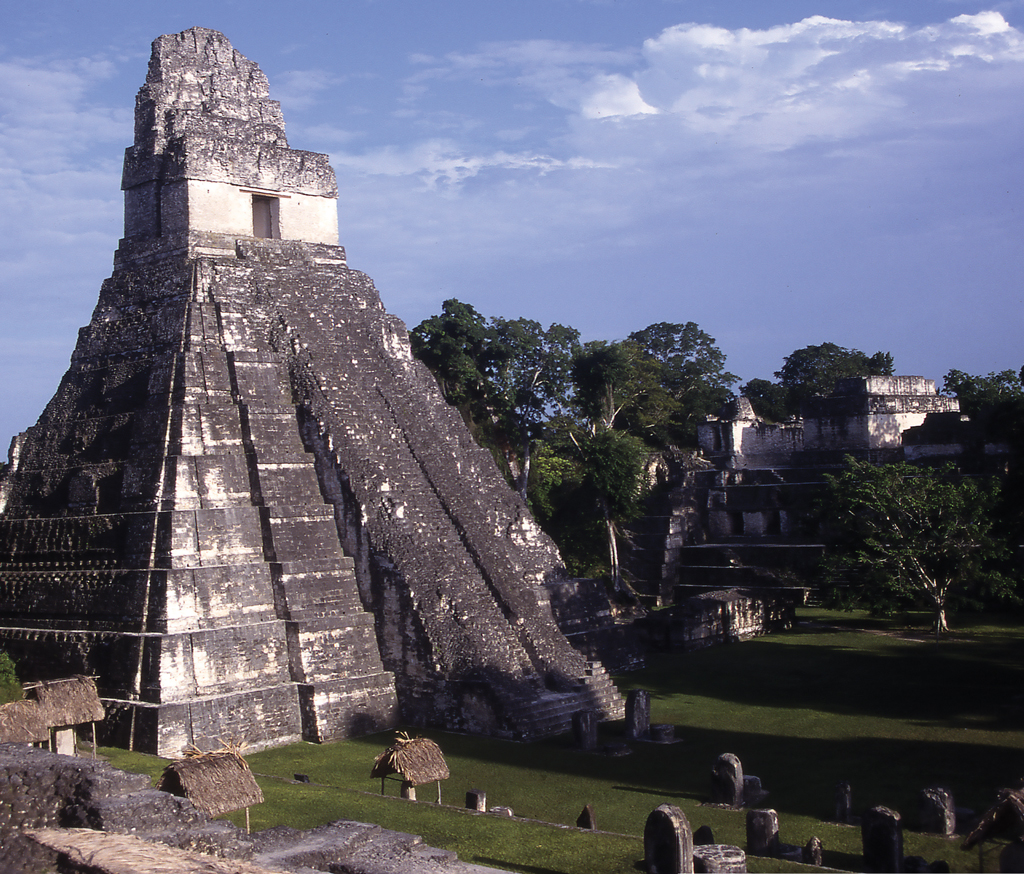
THE ANCIENT AMERICAS are a diverse and fascinating part of the world, and their societies contribute an important chapter to the human story. Given that all their major social developments—be it urbanism, writing, organized religions, or political hierarchies— were built from scratch, independent of any influence from the Old World, we can see them as an alternate experiment in what society and culture can be. What they achieved that is unique and surprising tells us something about the creativity and problem-solving talents of humankind, while the ways in which they repeated solutions seen across the world emphasizes the cognitive capacities we all share.
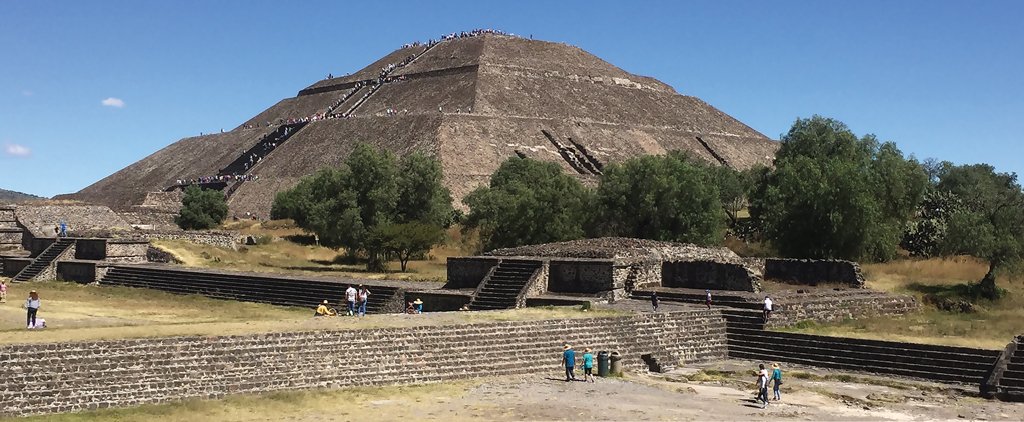
ORGANIZING THEMES IN THE GALLERY
We use artifacts to tell that story, emphasizing two particular themes. The first focuses on the close connection between political and divine power, as rulers sought to acquire supernatural attributes and embed their right to rule in a cosmic order. Forces of nature, aggressive predators, and celestial objects were all enlisted to legitimize personal and dynastic authority. The second theme explores how, no matter how different they might appear, all the cultures in this Gallery were connected and that common threads run throughout the cultural fabric of the region. In several places we present special cross-cultural sections that highlight these commonalities.
THE OLMEC AND THE CENTRAL MEXICAN HIGHLANDS
The organization of the Gallery is by culture and region, divided into seven distinct, color-coded zones, which reach from Mexico to the isthmus of Panama. We begin with the earliest steps beyond village life, exploring the Olmec and the groups they interacted with in the Central Mexican highlands. Best known for their colossal stone heads—believed to be the portraits of early kings—the Olmec were the first in this region to produce lofty temple pyramids, a sophisticated art system, and a codified pantheon of gods. The rise of political hierarchies is something we illustrate with the sculpture of an enthroned lord from the late Olmec period, about 500 BCE, a telling expression of personal authority. A key member of that pantheon was the Maize God. He first appears in Olmec carvings in jade and basalt by about 1500 BCE, just as corn cultivation was making an impact on population levels and speeding social complexity. Appearing in different forms in many other cultural zones, veneration of the Maize God would endure for the next 2,000 years. Indeed, in prayers for a good harvest it can be argued that this veneration survives to this day.
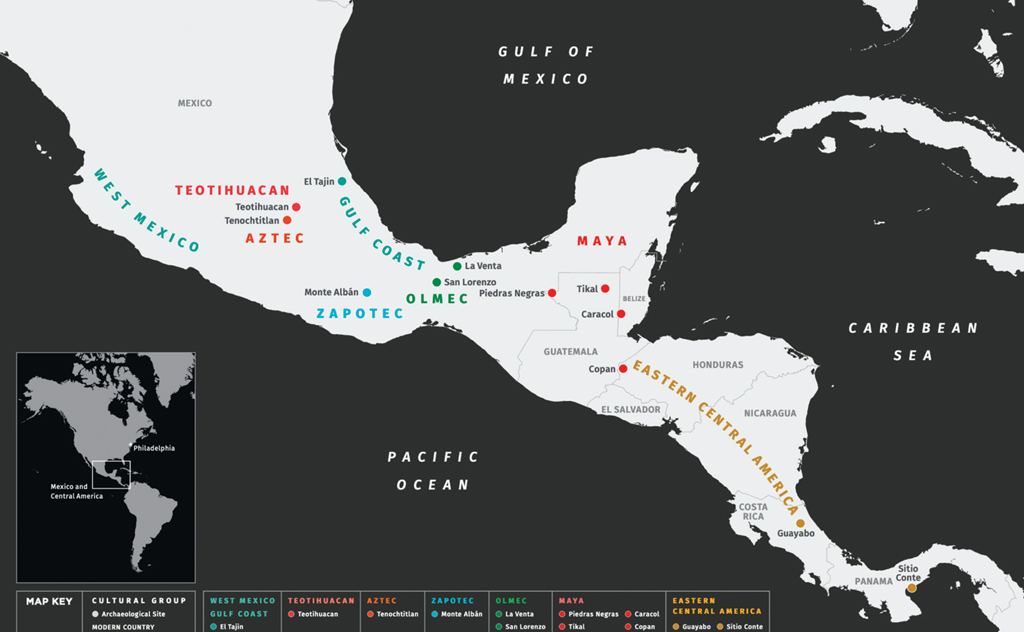
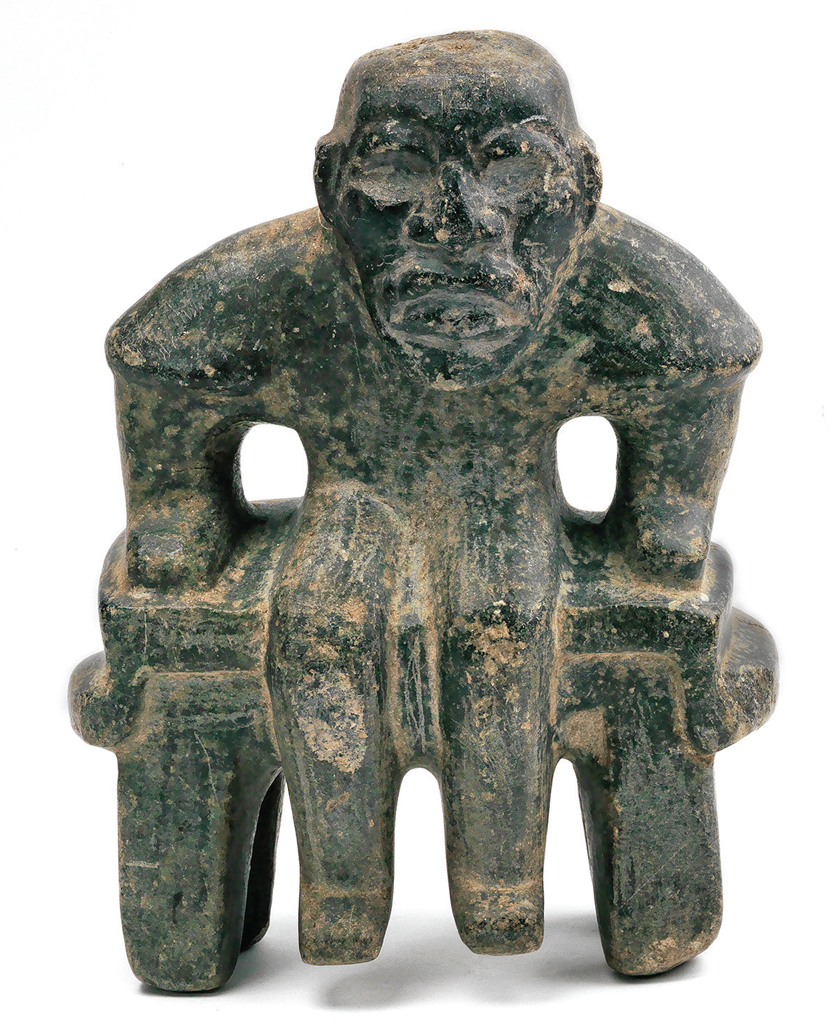
THE CITY OF TEOTIHUACAN
We turn next to Teotihuacan, which by 500 CE was one of the world’s largest cities and boasted a population of 100,000 or more people. The site is dominated by the massive pyramids of the Sun and Moon, which take their place within a rigid urban grid filled by other temple complexes and numerous residential compounds. Even the river that runs through the center of the city was channeled with right-angled turns to conform to the grid. Teotihuacan’s equally boxy architecture was in sympathy with an art-style that emphasized angles and hard edges. Almost every available surface in the city was painted in dazzling patterns and supernatural motifs, all in a rich palette of colors. Red and green survive on an incredibly rare three-dimensional sculpture of the so-called “Water Goddess,” a major Teotihuacan deity of water and fertility we display in the new Gallery. The only other complete example, vastly larger in size, was excavated at the base of the Pyramid of the Moon.
Some of the city’s most distinctive products were its “masks” carved in various hard greenstones. These were not worn—they never have holes for the eyes—but are believed to have been tied to mummy bundles or were used in other memorial effigies. In either case, they were idealized representations of the dead that invoked the beautiful and green-associated Maize God. Of the five masks included in our Gallery, one is a rare example with surviving inlays in its eyes.
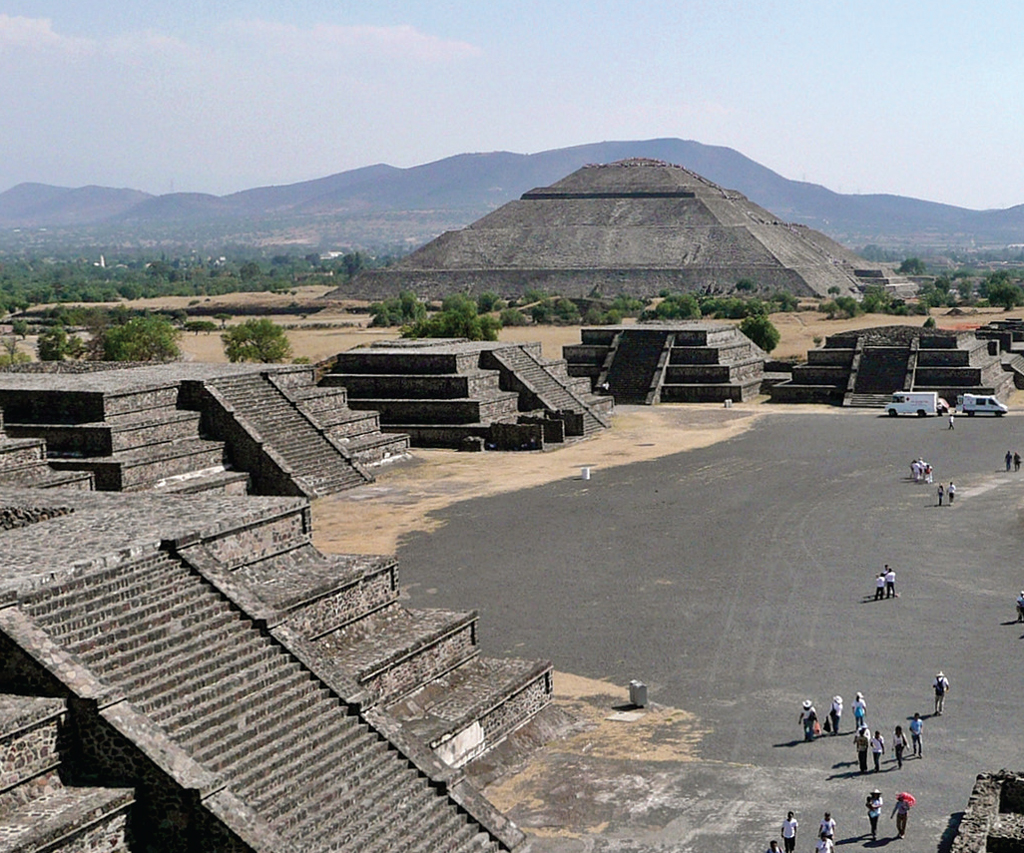
Teotihuacan was a cosmopolitan place. Excavations have revealed separate districts occupied by Zapotec, Maya, and Gulf Coast peoples. Why they were there is less clear. Their presence might point to trading missions or diplomatic embassies, or refer more darkly to the political subjection of those regions. We have good reason to think, for example, that Teotihuacan successfully invaded the Maya area in 378 CE, and depictions of Teotihuacan-style warriors in other cultural zones suggest they constructed the region’s earliest true empire.
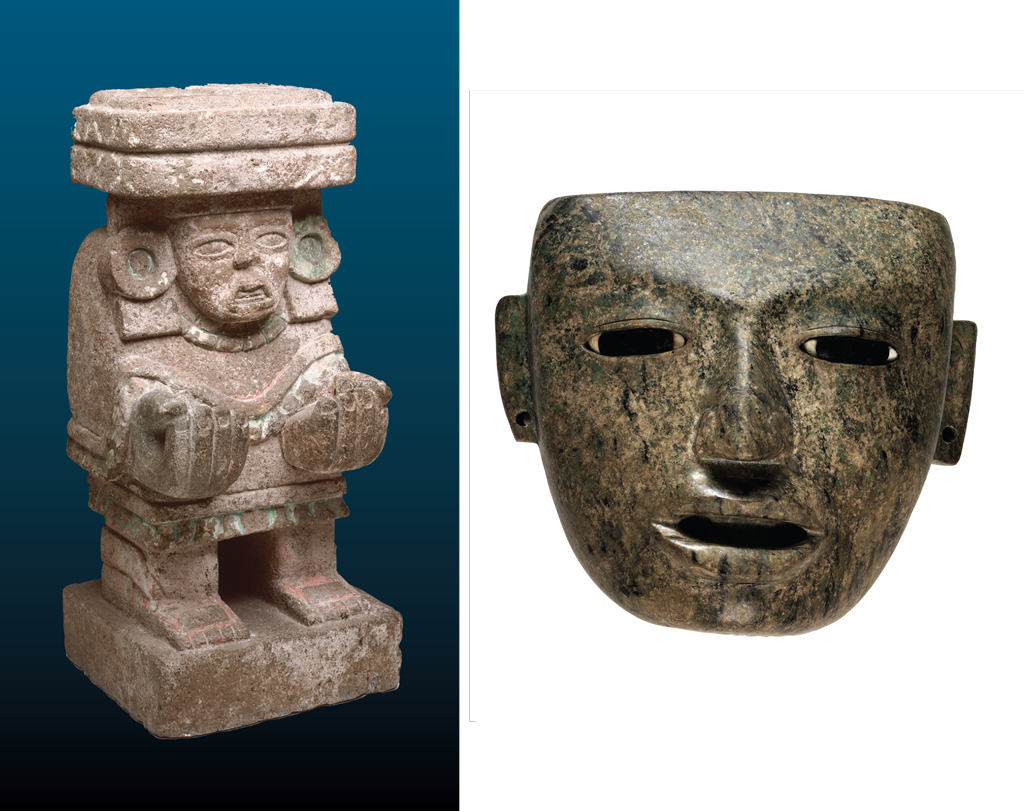
LEFT: Rare sculpture of the Teotihuacan Water Goddess. Philadelphia Museum of Art, The Louise and Walter Arensberg Collection, 1950, 1950-134-282.
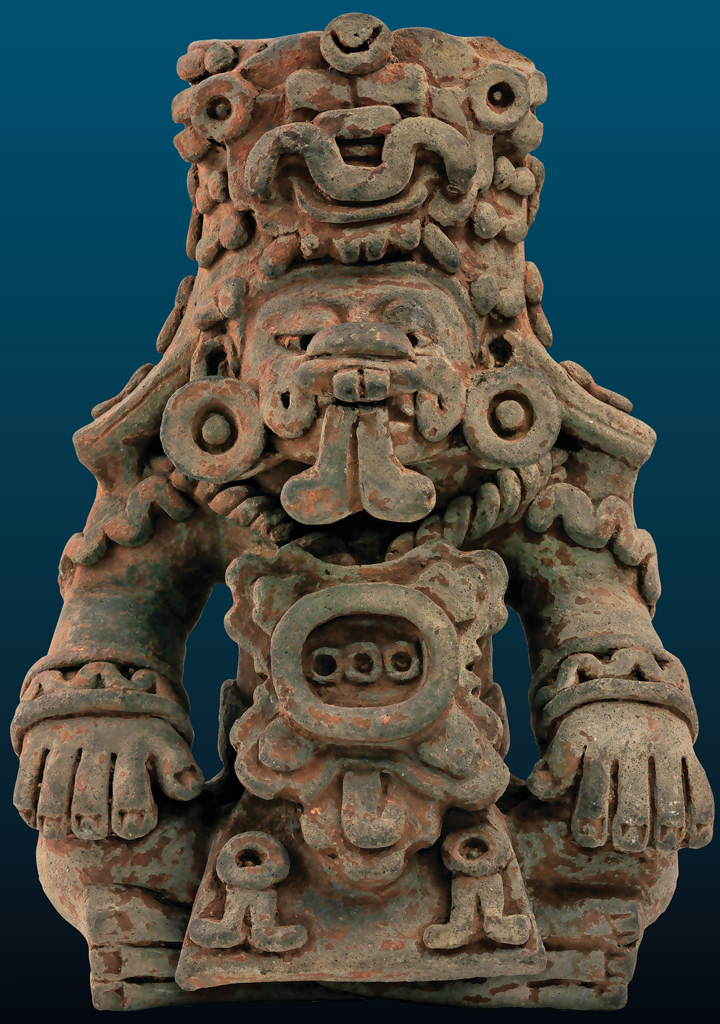
THE ZAPOTEC OF SOUTHERN MEXICO
Zapotec culture took root in the Valley of Oaxaca, where the Zapotec ruled from their hilltop capital of Monte Alban from 500 BCE to 700 CE. One of their most notable cultural products were ceramic “urns,” vessels embellished with the portraits of lords, many of which appear in the guise of gods. The Zapotec developed their own hieroglyphic script, but used a version of the sacred calendar common to almost all societies of the region—a system that probably dates back to Olmec times. Many of the dates we see in the art of the Zapotec and their contemporaries across Central Mexico are not, in fact, markers of time but rather personal names, monikers that were probably adopted from birthdays. We feature two sculptures that identify their lordly subjects in this way.
WEST MEXICO AND THE GULF COAST
A large central case covers West Mexico and the Gulf Coast. The former, consisting of the modern states of Jalisco, Colima, and Nayarit, was home to some vibrant cultures that built no major cities but are known for producing large numbers of fine ceramic figurines. These were placed in tomb chambers cut at the base of vertical shafts to accompany the dead. Their subjects range from the portraits of ancestors—twinned males and females— to those of warriors, priests, playful dogs, as well as to lively scenes of everyday life, including ceremonies and ballgames.
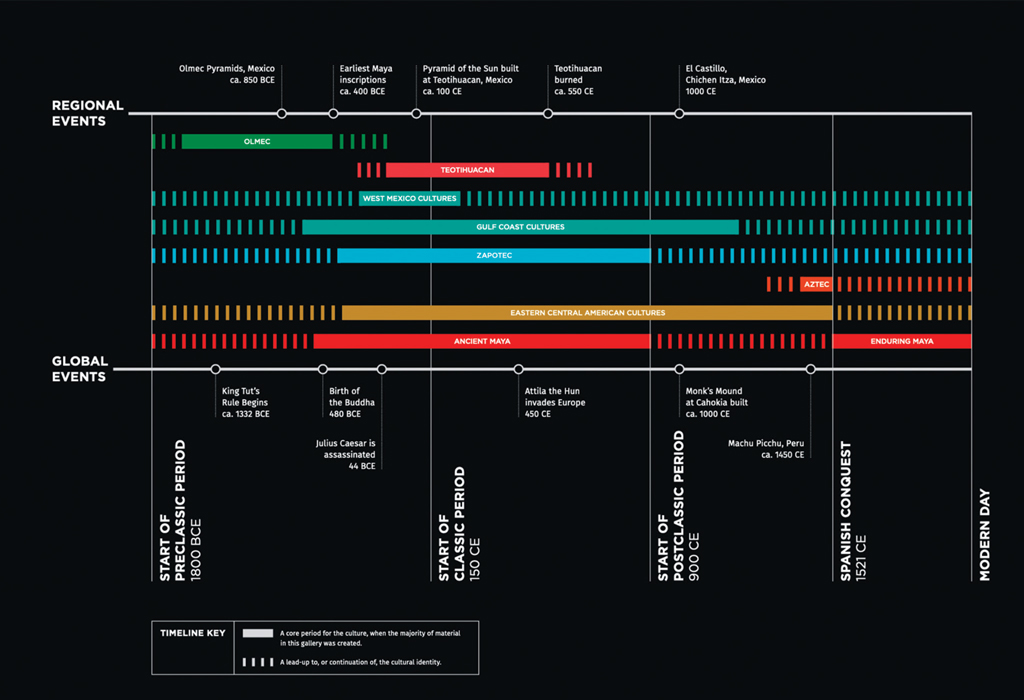
The section on the Gulf Coast includes all of what is today the state of Veracruz. This area thrived after the fall of Teotihuacan and features the great city of El Tajin, which enjoyed its apogee between 600 and 1000 CE. El Tajin culture developed a distinctive style of sinuous, interlaced scrollwork, completely unlike those angular forms at Teotihuacan. The city has 20 separate ballcourts and special energies went into the art that surrounded the game—which was both a true sport and a ritualistic performance of myth. Shared by many cultures, and still played in one part of Mexico today, we use another cross-cultural section to describe the basics of the game and show some superb examples of the players’ equipment. Originally made from wood and other perishable materials, what survives today are ceremonial versions made in stone. These consist of thick protective belts called yokes, as well as hachas and palmas, two kinds of attachment to the yoke. These may originally have had some function in the game, but their primary role was to carry emblematic motifs. These motifs are varied, but birds, skulls, crocodiles, and bundles of darts are some of the most popular and are among those we have on display.
The main Gulf Coast section features a miniature hacha in the form of a ballplayer’s head. Objects of this scale further emphasize that we are looking at ceremonial items, possibly even trophies, not practical equipment. A particular highlight in this case is the column fragment from El Tajin, thought to be the only one on display outside Mexico. It surely comes from a series of columns in a great palace at the highest point of the city, all dedicated to the king 13 Rabbit, who ruled at some point between 800 and 1000 CE.
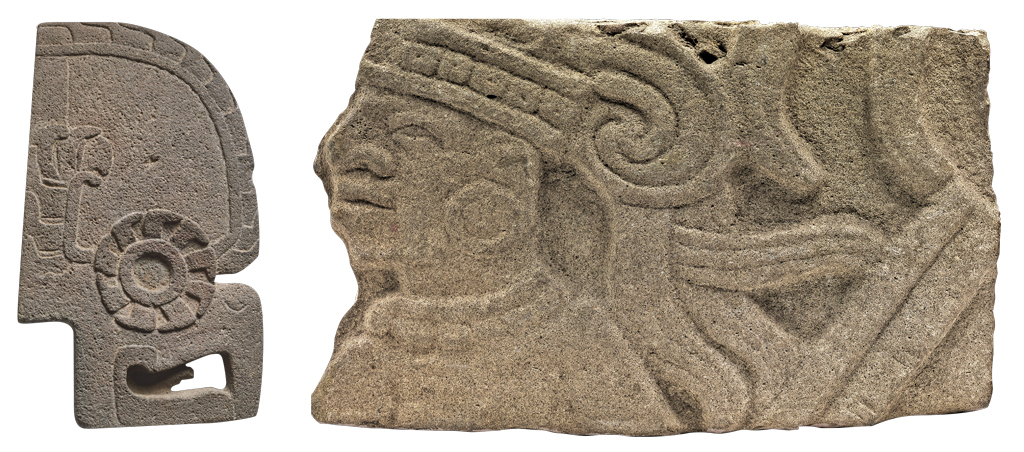
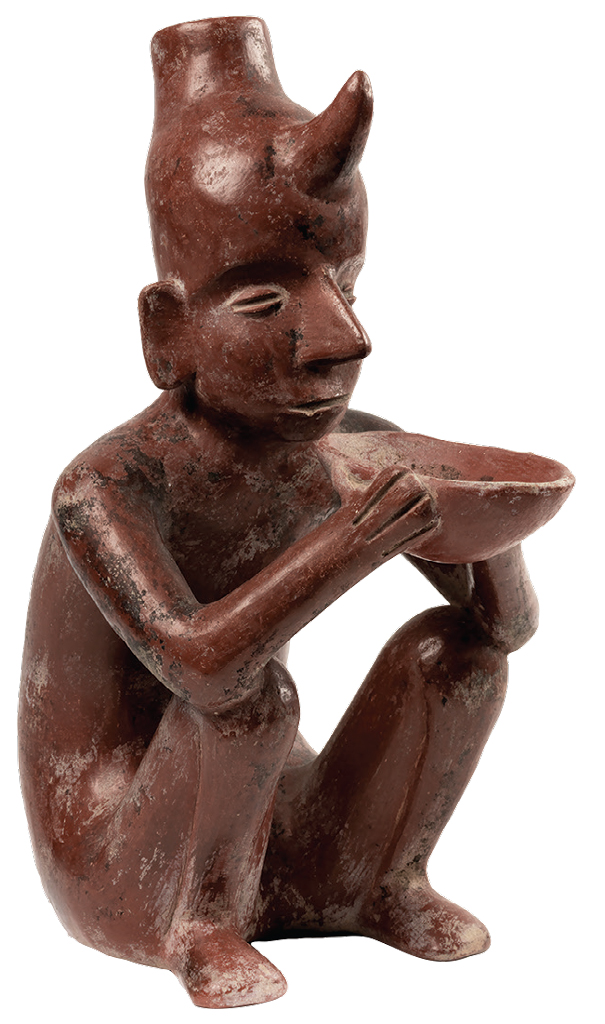
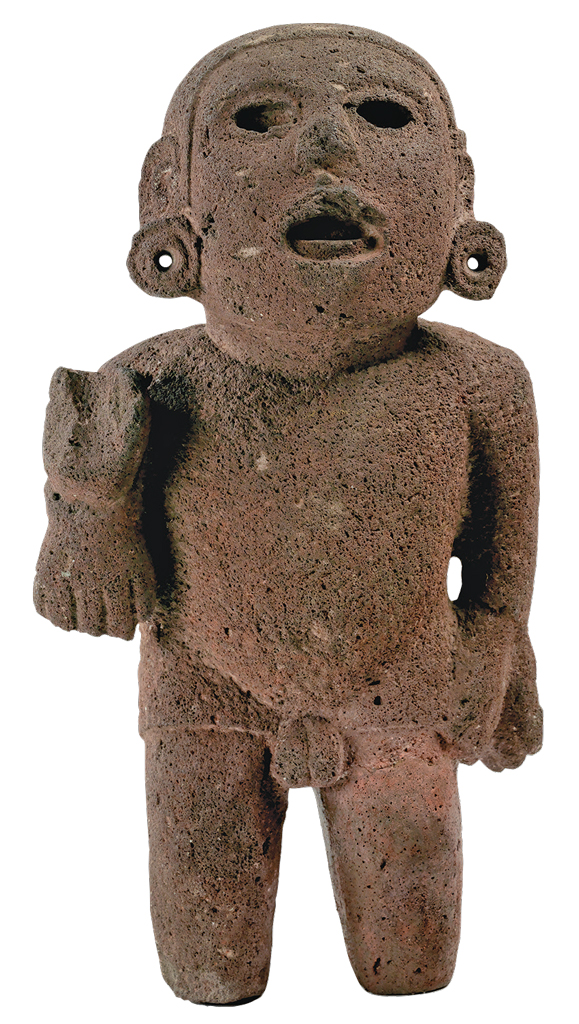
PM object 87-42-405.
THE AZTEC EMPIRE
The Aztec are the best known of all the societies featured in the Gallery. Their empire dominated Central Mexico as well as some territories far beyond, from 1428 until 1521, the year they were defeated by the invading Spaniards led by Hernán Cortés—the beginning of the end for the indigenous societies of the Americas. The Aztec Empire was actually an alliance of three kingdoms, with the dominant Mexica ruling from their capital Tenochtitlan (now beneath Mexico City) with lesser “co-capitals” situated at Texcoco and Tlacopan. At the heart of Tenochtitlan was a large sacred precinct, the symbolic, political, and religious hub of the empire. Recent archaeology confirms that it was the scene of grisly human sacrifices, and in our Gallery we include a sculpture of the fearsome god Xipe Totec, who wears the flayed skin of a victim as a body- suit. The principal location of these ritualistic killings was the Templo Major, a mighty pyramid surmounted by two temples, a structure rebuilt and enlarged on several occasions. One sculpture on exhibit, a giant conch shell in stone, is a close match for others found at the Templo Major, and there is reason to think that it originally came from one of its phases or from somewhere else within the sacred precinct.
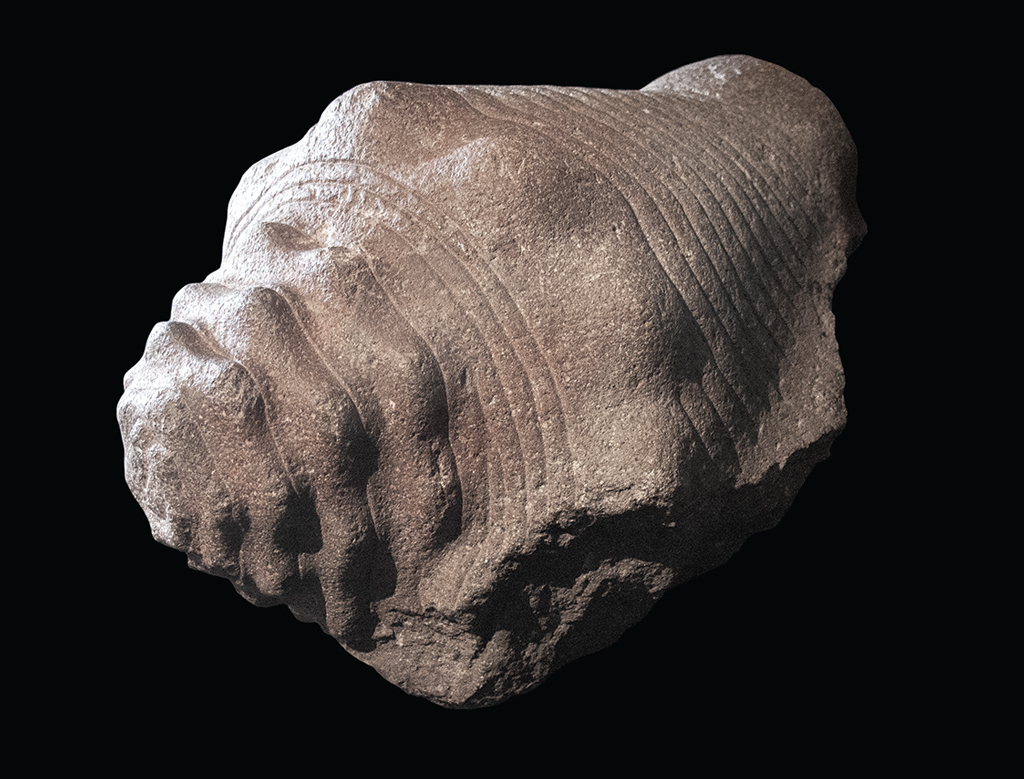
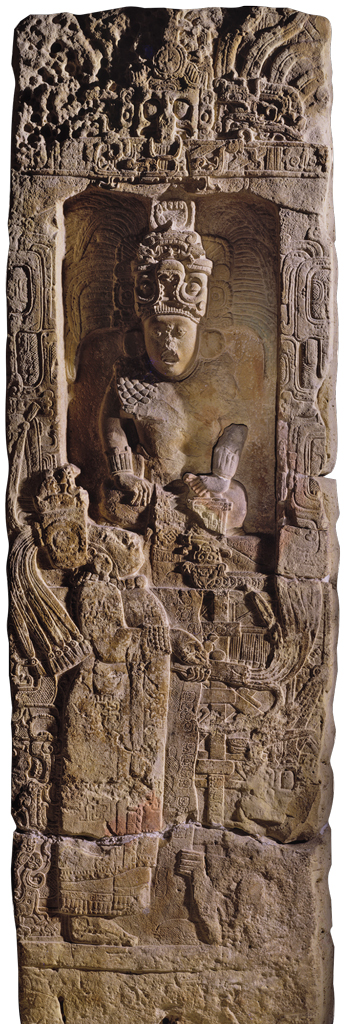
EASTERN CENTRAL AMERICA
Eastern Central America encompasses a range of cultures reaching through Honduras, El Salvador, Nicaragua, Costa Rica, and Panama to the northern tip of South America. This narrow isthmus was always a conduit for people and ideas traveling north or south, and the art of this intermediate zone shows those mixed influences. Highlights include grinding stones (metates) from Honduras or Costa Rica fashioned with images of a fire-breathing serpent and a crocodile, as well as ornately carved marble vessels from Honduras. We also include objects recovered in the Penn Museum’s excavations at Sitio Conte, Panama, in 1940. These included ceramics decorated with their characteristic fantastic animals and a considerable amount of gold, including large plaques featuring the same composite supernatural beings.
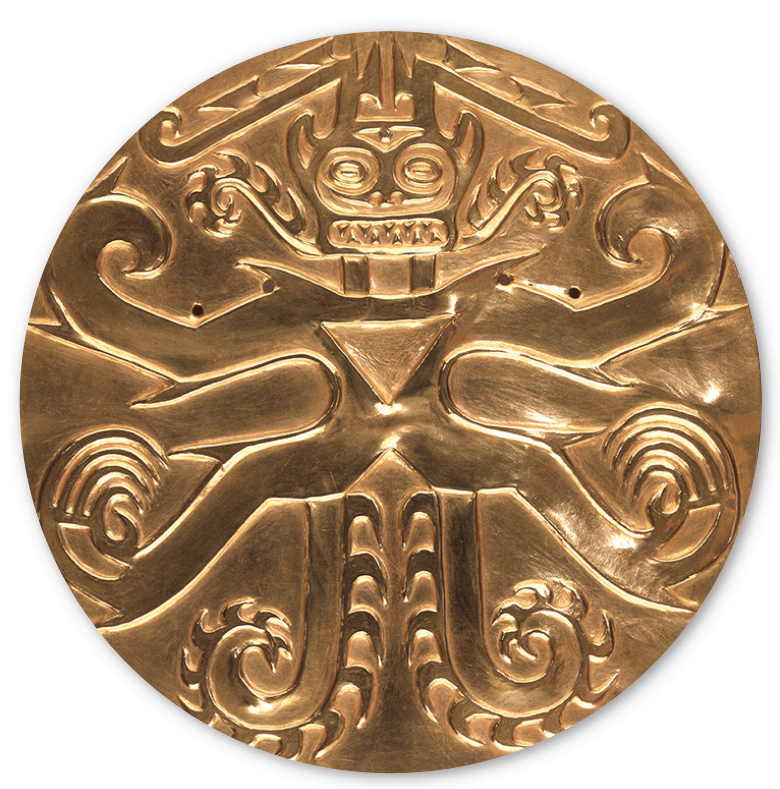
THE ANCIENT MAYA
In the last section, we come to the traditional strength
of the Penn Museum, the ancient Maya. The Maya have one of the longest continuous histories in the region, and many contemporary Maya people maintain their identity and work toward cultural revitalization in the modern nations they find themselves in. Indeed, we begin with a section called “Maya Today”—curated by my colleague Dr. Lucy Fowler Williams (see page 28)—that focuses on the textiles and masks that continue much earlier ideas and craft techniques.
Five tall Maya stelae provide imposing statements to the majesty of Maya kingship, which reached its peak in the Classic Period 250–900 CE. The iconic monument here is Piedras Negras Stela 14, which celebrates the accession of a local king in 758 CE. Finely preserved, the monument even includes the hieroglyphic names of the sculptors who carved it. Stela 14 played a part in a major breakthrough in reading Maya hieroglyphs in 1960. One of a set analyzed by Tatiana Proskouriakoff, a former Museum staff member, it helped to show that the inscriptions were historical rather than religious in nature and thereby opened a door leading to the modern decipherment. To explore this topic further we have an area dedicated to Maya hieroglyphs, where we explain how they work. Nearby is our collection of painted cylinder vessels that show lordly and mythic scenes as well the fearsome face of personified stone, originally the leg of an altar at Piedras Negras.
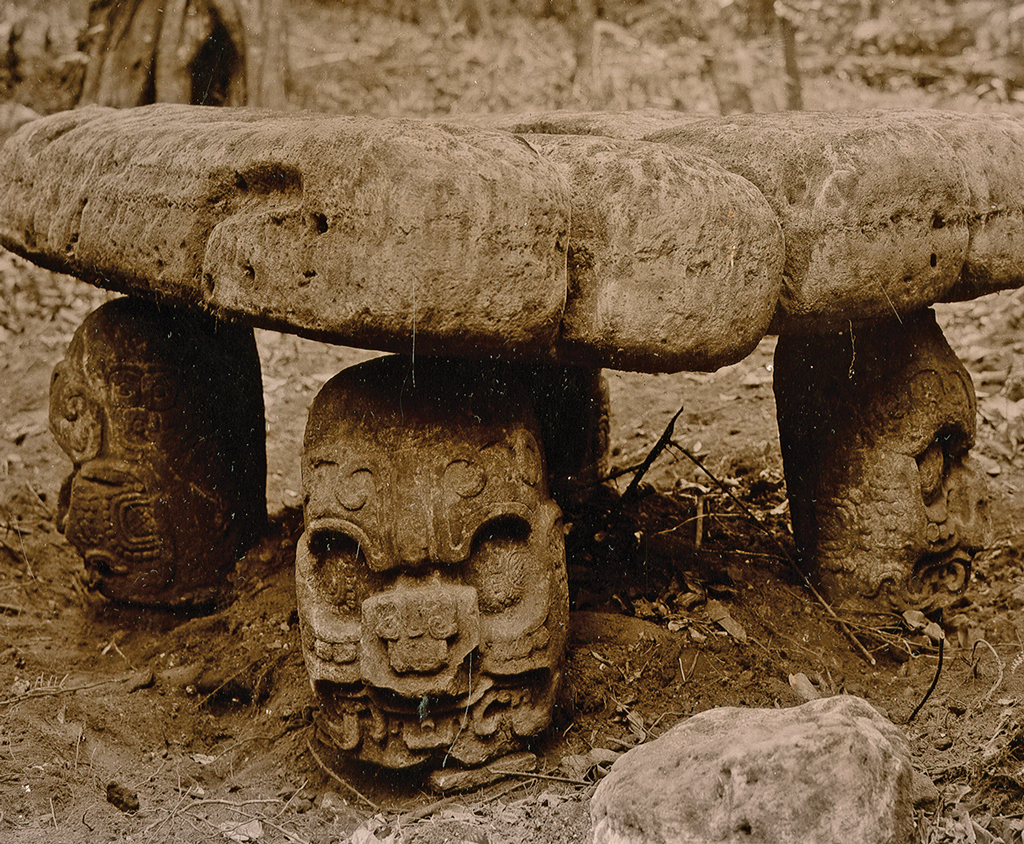
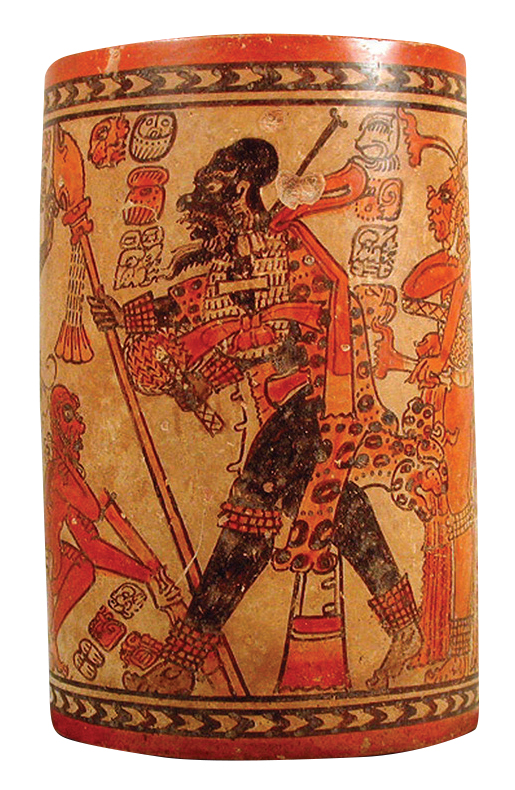
The reimagined Mexico and Central America Gallery is designed to inspire new appreciation for the cultural and artistic achievements of the peoples of this region. Those achievements stand proudly next to those of the Classical World, the Middle East, Africa, and Asia, as part of the rich tapestry of the human past that still impresses and informs us in the present.
Simon Martin, Ph.D., is Associate Curator and Keeper of Collections in the American Section and is lead curator of the Mexico and Central America Gallery.
FOR FURTHER READING
Miller, M. E. Art of Mesoamerica: From Olmec to Aztec. New York: Thames and Hudson, 2012.
Mexico: Splendors of Thirty Centuries. New York: Metropolitan Museum of Art, 1990.
